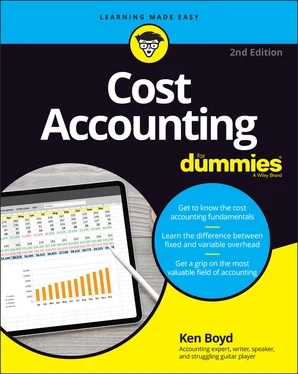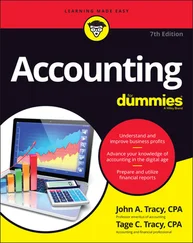Kenneth W. Boyd - Cost Accounting For Dummies
Здесь есть возможность читать онлайн «Kenneth W. Boyd - Cost Accounting For Dummies» — ознакомительный отрывок электронной книги совершенно бесплатно, а после прочтения отрывка купить полную версию. В некоторых случаях можно слушать аудио, скачать через торрент в формате fb2 и присутствует краткое содержание. Жанр: unrecognised, на английском языке. Описание произведения, (предисловие) а так же отзывы посетителей доступны на портале библиотеки ЛибКат.
- Название:Cost Accounting For Dummies
- Автор:
- Жанр:
- Год:неизвестен
- ISBN:нет данных
- Рейтинг книги:4 / 5. Голосов: 1
-
Избранное:Добавить в избранное
- Отзывы:
-
Ваша оценка:
- 80
- 1
- 2
- 3
- 4
- 5
Cost Accounting For Dummies: краткое содержание, описание и аннотация
Предлагаем к чтению аннотацию, описание, краткое содержание или предисловие (зависит от того, что написал сам автор книги «Cost Accounting For Dummies»). Если вы не нашли необходимую информацию о книге — напишите в комментариях, мы постараемся отыскать её.
Cost Accounting For Dummies
Cost Accounting For Dummies
Cost Accounting For Dummies — читать онлайн ознакомительный отрывок
Ниже представлен текст книги, разбитый по страницам. Система сохранения места последней прочитанной страницы, позволяет с удобством читать онлайн бесплатно книгу «Cost Accounting For Dummies», без необходимости каждый раз заново искать на чём Вы остановились. Поставьте закладку, и сможете в любой момент перейти на страницу, на которой закончили чтение.
Интервал:
Закладка:
Deciding on relevance
Make a judgment about what you believe to be relevant. Relevant means “important enough” to consider in a decision (see Chapter 11). Your threshold for considering relevance might be expressed as a dollar amount. Maybe any amount over $10,000 is relevant to you. Relevance can also be expressed as a percentage. You might consider a change of 10 percent or more to be relevant.
When you decide what amount or percentage is relevant, you use it as a filter for decision-making. Anything over the threshold needs to be analyzed and considered in your decision-making. Below the threshold, you “pass further analysis” — a term my old CPA firm used to mean “not important enough to investigate.”
Demanding quality
Demand is a strong word, but it should be applied to quality. You will not succeed as a business without a constant focus on quality. It’s simply too easy for customers to use technology to find a better product or service somewhere else.
Quality means more than making a product or service that the client wants. The term also means fixing your product, if it doesn’t work.
Finally, quality means asking customers what changes they want in your product or what new products they would like to see. Ask your customers, and they’ll gladly tell you.
Chapter 2
Brushing Up on Cost Accounting Basics
IN THIS CHAPTER
 Distinguishing between direct and indirect costs
Distinguishing between direct and indirect costs
 Understanding fixed and variable costs
Understanding fixed and variable costs
 Comparing the costs incurred in different industries
Comparing the costs incurred in different industries
 Defining a cost driver
Defining a cost driver
 Recognizing inventoriable costs
Recognizing inventoriable costs
This chapter provides the rules of the road for cost accounting. Use these basic terms and ideas to understand more complex topics later in the book. If you read another chapter and start to get lost, head back here and take a look at these concepts again.
Understanding the Big Four Terms
Direct costs, indirect costs, fixed costs, and variable costs are the four most important cost accounting terms … and these four terms can be confusing. The following sections outline a process for understanding the differences among these words. If you follow this process, you should be able to keep these important terms straight in your mind. Ready? Let’s go!
Comparing direct and indirect costs
Direct costs are costs you can trace (or tie) to your product or service. Indirect costs can’t be traced directly to the product or service. Instead, indirect costs are allocated. (Indirect costs are also referred to as overhead costs. )
Material and labor costs are good examples of direct costs. Say you manufacture cotton gloves. You buy cotton, yarn, and leather to make the gloves. You can trace the materials directly to the gloves; for example, you can take a glove apart and see the materials that were used to create it. Cotton, yarn, and leather are considered direct material costs, because they can be directly tied to one unit of product.
You pay workers to cut, sew, and dye the materials. Because you can trace the hourly labor cost directly to the gloves, these costs are direct labor costs. You can review each employee time sheet and determine how many hours each employee worked, and how many gloves he or she moved through production.
Indirect costs can’t be traced directly to a product or service. So instead, they have to be allocated. You typically allocate costs by assigning a cost per unit. The per-unit rate attaches all the indirect costs to your products. The term overhead is also used to describe indirect costs.
Allocating indirect costs
To allocate overhead, you need to compute a rate or amount of cost per product. Assume you lease the building where you manufacture the cotton gloves. Obviously, the reason you’re leasing the building is to make gloves.
You can’t trace the cost of the lease to any particular pair of gloves. The cost belongs to all the gloves, yet the cost does need to be included in the cost of a single unit of your product. That way, you can determine the price and profit for one unit (one glove).
 It’s worth mentioning again and again: Every cost must be attached (traced or allocated) to a product or service that is sold.
It’s worth mentioning again and again: Every cost must be attached (traced or allocated) to a product or service that is sold.
One way to allocate overhead is to base it on some level of activity. As you see later in Chapter 5, activities in your business cause you to incur costs. Assume you run a machine for 1,000 hours a year and pay $2,000 for the repair and maintenance on the machine. You could allocate the repair cost to each hour of machine time as $2,000 ÷ 1,000 hours, or $2 per machine hour.
Deciding on direct versus indirect costs
As a business owner, you need to analyze all your costs and decide which ones are direct and which ones are indirect. One way to do that is to visualize your product. Look at that pair of gloves one more time. You can certainly picture the materials (cotton, yarn, and leather) used in a pair of gloves. Also, you can visualize a worker cutting the cotton and sewing it together.
That exercise should convince you that material and labor are direct costs. You can imagine those costs “traveling along” with the gloves as they are produced, packaged, and shipped to a customer. Okay, direct costs. Got it.
Working with direct costs in cost planning is preferable because direct costs are known. In the previous example, you defined material and labor costs as direct, because you can attach the costs directly to the product. If the costs are known, your planning is more precise. Actual costs are likely close to your planned amounts. Because indirect costs are based on estimates, your budgeted costs are less precise.
Next, you review your checkbook to find other costs. You find checks for vehicle insurance for a truck. Consider what you just read in the previous section. Insurance costs can’t be traced directly to the gloves, so you need to decide on an activity level to allocate the costs.
The truck’s insurance cost can be allocated based on the number of miles you drive the truck. Assume you compute an insurance allocation of $0.10 per mile. You now need to get the cost allocated to your product.
Instead of allocating the cost to individual pairs of gloves, you allocate costs to each shipment of gloves. When a customer orders gloves, they are packed up and shipped, using the truck. Based on the number of miles driven to a client, you can allocate the truck insurance cost.
 Indirect costs can be allocated using many levels and kinds of activity. You’ve seen how costs can be allocated by product and by shipment. As you see later in the book, you can allocate costs by company department or product line. As long as the cost is eventually allocated to a product or service, you can justify many methods of indirect cost allocation.
Indirect costs can be allocated using many levels and kinds of activity. You’ve seen how costs can be allocated by product and by shipment. As you see later in the book, you can allocate costs by company department or product line. As long as the cost is eventually allocated to a product or service, you can justify many methods of indirect cost allocation.
Интервал:
Закладка:
Похожие книги на «Cost Accounting For Dummies»
Представляем Вашему вниманию похожие книги на «Cost Accounting For Dummies» списком для выбора. Мы отобрали схожую по названию и смыслу литературу в надежде предоставить читателям больше вариантов отыскать новые, интересные, ещё непрочитанные произведения.
Обсуждение, отзывы о книге «Cost Accounting For Dummies» и просто собственные мнения читателей. Оставьте ваши комментарии, напишите, что Вы думаете о произведении, его смысле или главных героях. Укажите что конкретно понравилось, а что нет, и почему Вы так считаете.












